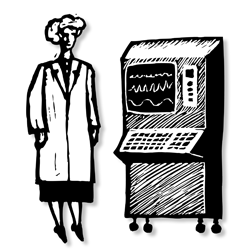|
|
|
SECRETS FOR SYSTEM SECURITY

|
|

|
How
to safeguard data
from... Melvin
When thinking about safeguarding your
data, you probably think about outside threats or disgruntled
employees. But what about the
good employee, hard working Melvin?
Melvin the...
... bad speller. He’s writing an invoice
note to a client to help them better understand what’s
being billed. But, honestly, Mel can’t spell! Turn on his
Clients & Profits spell checker. It’s an automatic
way to improve his spelling.
... messy time tracker. He
confuses one task for another or adds ten hours
instead of one. Require time approvals. Staffers
add their time as usual, a manager reviews
an unapproved time report, and catches any
errors. Once edited, time can be approved.
... accounting illiterate.
He’s daydreaming about winning the lottery
while adding A/P invoices and edits account
numbers to match his ticket. Safeguard against
posting to a wrong G/L account by adding default
G/L accounts and not letting users edit account
numbers.
... crazy account coordinator.
He’s working for many AEs and isn’t
really crazy, just busy. Help him make adding
new jobs quick, easy, and consistent. Use job
type/spec sheets with the right tasks for work
your shop does regularly.
... speeding traffic manager.
Just get out of his way. Status codes classify
a job’s development but where’s
the safety net? Set up default status codes
for new, closed, and reopened jobs so that
no job is ever without one.
... world-class shopper. His
dream job is being a buyer for HSN; but right
now, he’s working for you. Can’t
control his usual impulse to buy the biggest,
baddest, and best? Set a dollar amount limit
to purchase orders that he adds to control
his purchases even when you’re not around.
|
|
By Chris
Lawrence
 Using
firewalls is the first line of defense to keep your system
safe from outside intruders. But what about insiders? Using
firewalls is the first line of defense to keep your system
safe from outside intruders. But what about insiders?
 Nearly
everyone is capable of wreaking havoc on your database and
stored files. But your system manager can take simple (and
often overlooked) steps to make sure that your shop’s
files stay safe from cranky employees and IT idiots. Nearly
everyone is capable of wreaking havoc on your database and
stored files. But your system manager can take simple (and
often overlooked) steps to make sure that your shop’s
files stay safe from cranky employees and IT idiots.
 First,
make sure that everyone changes their passwords often, at least
monthly. You can take this one step further and assign passwords
to your staff instead of letting them choose to help prevent
easily deciphered (i.e., hackable) user access. First,
make sure that everyone changes their passwords often, at least
monthly. You can take this one step further and assign passwords
to your staff instead of letting them choose to help prevent
easily deciphered (i.e., hackable) user access.
 Next,
limit user access to the servers. Set them up in the system
manager’s office (no one will get past the system manager
unscathed) or lock them in a room. Next,
limit user access to the servers. Set them up in the system
manager’s office (no one will get past the system manager
unscathed) or lock them in a room.
 Control
who has access to which files by segmenting your server or
storing information in different places, such as putting your
Clients & Profits database on a different Control
who has access to which files by segmenting your server or
storing information in different places, such as putting your
Clients & Profits database on a different
|
|
server than your client
files. Use server permissions to create custom access to servers,
such as read-only or read/write, in addition to log-in privileges.
 When
someone leaves your company, be sure to deactivate them as
a user in Clients & Profits, especially if they have remote
access set up through My C&P! If they have other remote
access to your servers, be sure to change their passwords or
delete their access altogether. When
someone leaves your company, be sure to deactivate them as
a user in Clients & Profits, especially if they have remote
access set up through My C&P! If they have other remote
access to your servers, be sure to change their passwords or
delete their access altogether.
 And
of course, when you and an employee part ways, change the alarm
code and collect their keys. And
of course, when you and an employee part ways, change the alarm
code and collect their keys.
 Remember,
your system can be the conduit for mayhem or the vehicle for
security. But no matter what technical gizmo you’ve got
installed, it won’t stop bad guys from trying. But pair
your technology with good old-fashioned vigilance and you’ll
have a pretty solid—and secure—system. Remember,
your system can be the conduit for mayhem or the vehicle for
security. But no matter what technical gizmo you’ve got
installed, it won’t stop bad guys from trying. But pair
your technology with good old-fashioned vigilance and you’ll
have a pretty solid—and secure—system.
Chris Lawrence is a senior member of
the Clients & Profits support team.
|
|

|
|
|
|
|